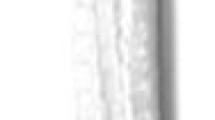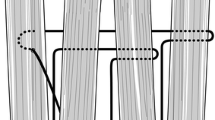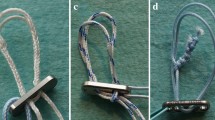Abstract
Purpose
The purpose was to investigate graft slippage and ultimate load to failure of a femoral press-fit fixation technique for anterior cruciate ligament (ACL) reconstruction.
Methods
Nine fresh-frozen knees were used. Standardized harvesting of the B-PT-B graft was performed. The femora were cemented into steel rods, and a tunnel was drilled outside-in into the native ACL footprint and expanded using a manual mill bit. The femoral bone block was fixed press-fit. To pull the free end of the graft, it was fixed to a mechanical testing machine using a deep-freezing technique. A motion capture system was used to assess three-dimensional micro-motion. After preconditioning of the graft, 1000 cycles of tensile loading were applied. Finally, an ultimate load to failure test was performed. Graft slippage in mm ultimate load to failure as well as type of failure was noted.
Results
In six of the nine measured specimens, a typical pattern of graft slippage was observed during cyclic loading. For technical reasons, the results of three knees had to be discarded. 78.6 % of total graft slippage occurred in the first 100 cycles. Once the block had settled, graft slippage converged to zero, highlighting the importance of initial preconditioning of the graft in the clinical setting. Graft slippage after 1000 cycles varied around 3.4 ± 3.2 mm (R = 1.3–9.8 mm) between the specimens. Ultimate loading (n = 9) revealed two characteristic patterns of failure. In four knees, the tendon ruptured, while in five knees the bone block was pulled out of the femoral tunnel. The median ultimate load to failure was 852 N (R = 448–1349 N).
Conclusion
The implant-free femoral press-fit fixation provided adequate primary stability with ultimate load to failure pull forces at least equal to published results for interference screws; hence, its clinical application is shown to be safe.




Similar content being viewed by others
References
Ahmad CS, Gardner TR, Groh M et al (2004) Mechanical properties of soft tissue femoral fixation devices for anterior cruciate ligament reconstruction. Am J Sports Med 32(3):635–640
Arnold MP, Biedert RM, Loon C et al (2012) Isoanatomical bone-patellar tendon-bone single-bundle ACL reconstruction: the wedge that gives the edge! Eur J Orthop Surg Traumatol 22(1):77–80
Arnold MP, Duthon V, Neyret P et al (2013) Double incision iso-anatomical ACL reconstruction: the freedom to place the femoral tunnel within the anatomical attachment site without exception. Int Orthop (SICOT) 37(2):247–251
Arnold MP, Friederich NF, Müller W et al (2013) From open to arthroscopic anatomical ACL-reconstructions: the long way round. A statement paper. Knee Surg Sports Traumatol Arthrosc 21(7):1478–1481
Beynnon BD, Amis AA (1998) In vitro testing protocols for the cruciate ligaments and ligament reconstructions. Knee Surg Sports Traumatol Arthrosc 6(Suppl 1):S70–S76
Bouattour K, Châtain F, Ait Si Selmi T et al (2002) Arthroscopic reconstruction of the anterior cruciate ligament. Rev Chir Orthop Reparatrice Appar Mot 88(2):130–138
Brown CH, Spalding T, Robb C (2013) Medial portal technique for single-bundle anatomical anterior cruciate ligament (ACL) reconstruction. Int Orthop (SICOT) 37(2):253–269
Coleridge S, Amis A (2004) A comparison of five tibial-fixation systems in hamstring-graft anterior cruciate ligament reconstruction. Knee Surg Sports Traumatol Arthrosc 12(5):391–397
Dejour H, Walch G, Neyret P et al (1988) Results of surgically treated chronic anterior laxities. Apropos of 251 cases reviewed with a minimum follow-up of 3 years. Rev Chir Orthop Reparatrice Appar Mot 74(7):622–636
Driscoll MD, Isabell GP, Conditt MA et al (2012) Comparison of 2 femoral tunnel locations in anatomic single-bundle anterior cruciate ligament reconstruction: a biomechanical study. Arthroscopy 28(10):1481–1489
Fu SC, Cheng WH, Cheuk YC et al (2013) Effect of graft tensioning on mechanical restoration in a rat model of anterior cruciate ligament reconstruction using free tendon graft. Knee Surg Sports Traumatol Arthrosc 21(5):1226–1233
Gerich TG, Cassim A, Lattermann C et al (1997) Pullout strength of tibial graft fixation in anterior cruciate ligament replacement with a patellar tendon graft: interference screw versus staple fixation in human knees. Knee Surg Sports Traumatol Arthrosc 5(2):84–88
Göpfert B, Krol Z, Freslier M et al (2011) 3D video-based deformation measurement of the pelvis bone under dynamic cyclic loading. BioMed Eng OnLine 10:60
Hefzy MS, Grood ES (1988) Review of knee models. Appl Mech Rev 41(1):1–13
Hensler D, Working ZM, Illingworth KD et al (2011) Medial portal drilling: effects on the femoral tunnel aperture morphology during anterior cruciate ligament reconstruction. J Bone Joint Surg Am 93(22):2063–2071
Hertel P, Behrend H (2010) Fremdmaterialfreie vordere Kreuzbandplastik mit der Patellasehne in Press-fit-Doppelbündeltechnik. Unfallchirurg 113(7):540–548
Howell SM, Gittins ME, Gottlieb JE et al (2001) The relationship between the angle of the tibial tunnel in the coronal plane and loss of flexion and anterior laxity after anterior cruciate ligament reconstruction. Am J Sports Med 200129(5):567–574
Jomha NM, Raso VJ, Leung P (1993) Effect of varying angles on the pullout strength of interference screw fixation. Arthroscopy 9(5):580–583
Matthews LS, Lawrence SJ, Yahiro MA et al (1993) Fixation strengths of patellar tendon-bone grafts. Arthroscopy 9(1):76–81
Muller B, Duerr ER, van Dijk CN et al (2015) Anatomic anterior cruciate ligament reconstruction: reducing anterior tibial subluxation. Knee Surg Sports Traumatol Arthrosc. doi:10.1007/s00167-015-3612-x
Musahl V, Abramowitch SD, Gabriel MT et al (2003) Tensile properties of an anterior cruciate ligament graft after bone-patellar tendon-bone press-fit fixation. Knee Surg Sports Traumatol Arthrosc 11(2):68–74
Paessler HH, Mastrokalos DS (2003) Anterior cruciate ligament reconstruction using semitendinosus and gracilis tendons, bone patellar tendon, or quadriceps tendon-graft with press-fit fixation without hardware. A new and innovative procedure. Orthop Clin North Am 34(1):49–64
Pavlik A, Hidas P, Czigány T et al (2004) Biomechanical evaluation of press-fit femoral fixation technique in ACL reconstruction. Knee Surg Sports Traumatol Arthrosc 12(6):528–533
Pernin J, Verdonk P, Si Selmi TA et al (2010) Long-term follow-up of 24.5 years after intra-articular anterior cruciate ligament reconstruction with lateral extra-articular augmentation. Am J Sports Med 38(6):1094–1102
Sarzaeem MM, Najafi F, Razi M et al (2014) ACL reconstruction using bone-patella tendon-bone autograft: press-fit technique vs. interference screw fixation. Arch Orthop Trauma Surg 134(7):955–962
Seil R, Rupp S, Krauss PW et al (1998) Comparison of initial fixation strength between biodegradable and metallic interference screws and a press-fit fixation technique in a porcine model. Am J Sports Med 26(6):815–819
Siebold R, Benetos IS, Sartory N et al (2010) How to avoid the risk of intraoperative cartilage damage in anatomic four tunnel double bundle anterior cruciate ligament reconstruction. Knee Surg Sports Traumatol Arthrosc 18(1):64–67
Simmons RHSM, Hull ML (2003) Effect of the angle of the femoral and tibial tunnels in the coronal plane and incremental excision of the posterior cruciate ligament on tension of an anterior cruciate ligament graft: an in vitro study. J Bone Joint Surg Am 85(6):1018–1029
Weimann A, Zantop T, Rümmler M et al (2003) Primary stability of bone-patellar tendon-bone graft fixation with biodegradable pins. Arthroscopy 19(10):1097–1102
Zantop T, Ruemmler M, Welbers B et al (2005) Cyclic loading comparison between biodegradable interference screw fixation and biodegradable double cross-pin fixation of human bone-patellar tendon-bone grafts. Arthrosc J Arthrosc Relat Surg 21(8):934–941
Acknowledgments
We thank the PROMOTIO Foundation for Biomechanics, Basel, and N.F. Friederich for the financial support of this study.
Author information
Authors and Affiliations
Corresponding author
Additional information
M. P. Arnold and L. D. Burger have contributed equally and share first-authorship.
Rights and permissions
About this article
Cite this article
Arnold, M.P., Burger, L.D., Wirz, D. et al. The biomechanical strength of a hardware-free femoral press-fit method for ACL bone–tendon–bone graft fixation. Knee Surg Sports Traumatol Arthrosc 25, 1234–1240 (2017). https://doi.org/10.1007/s00167-015-3960-6
Received:
Accepted:
Published:
Issue Date:
DOI: https://doi.org/10.1007/s00167-015-3960-6




